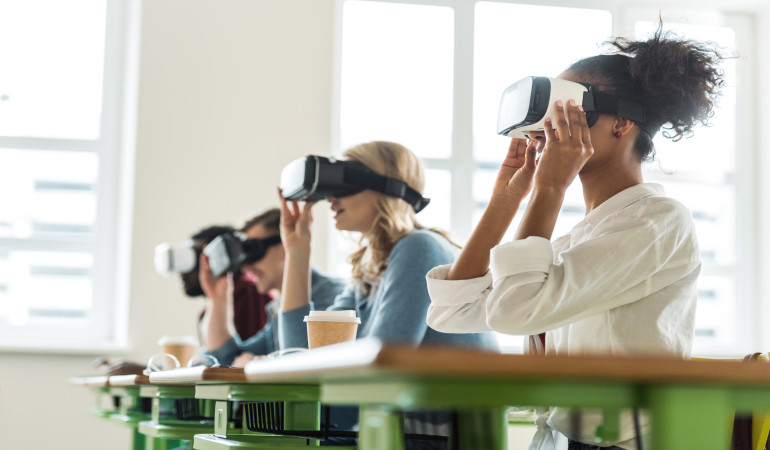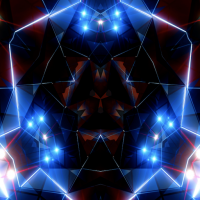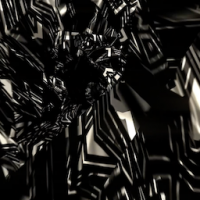Virtual Reality (VR) 101: An Extensive Course
Welcome to the world of virtual reality, a technology that has the potential to revolutionize the way we interact with computers, games, and other digital media. In this course, you will learn the basics of VR, including its history, current state, and future possibilities. We will cover the different types of VR, the hardware and software required, and the various applications of VR, including gaming, education, and therapy. By the end of this course, you will have a solid understanding of what VR is, how it works, and how you can use it in your own projects or applications.
January 17, 2023 05:31
Module 1: History and Overview of VR
In this module, we will take a look at the history of VR, from its early beginnings in the 1960s to the current state of the technology. We will explore the different types of VR, including non-immersive, semi-immersive, and fully-immersive VR. We will also discuss the various applications of VR, including gaming, education, and therapy.
Module 2: Hardware and Software
In this module, we will explore the hardware and software required to create and experience VR. We will discuss the different types of VR headsets, including PC-based, mobile, and standalone VR headsets. We will also explore the various input devices used in VR, including controllers, gloves, and body tracking systems. We will also discuss the software required to create VR content, including game engines, development platforms, and VR creation tools.
Module 3: Applications of VR
In this module, we will explore the various applications of VR, including gaming, education, and therapy. We will discuss how VR is used in gaming, including the different types of VR games and the benefits of VR gaming. We will also explore how VR is used in education, including virtual field trips, simulations, and language learning. We will also discuss how VR is used in therapy, including exposure therapy, pain management, and mental health treatment.
Module 4: Developing for VR
In this module, we will explore the process of developing for VR. We will discuss the different types of VR content, including games, applications, and experiences. We will also explore the different tools and platforms used to create VR content, including game engines, development platforms, and VR creation tools. We will also discuss the design principles and best practices for creating VR content, including user experience, interaction design, and accessibility.
Module 5: Future of VR
In this module, we will explore the future of VR, including new technologies, applications, and possibilities. We will discuss the advancements in VR hardware, including higher resolution displays, wireless VR, and haptic feedback. We will also explore the advancements in VR software, including machine learning, artificial intelligence, and social VR. We will also discuss the potential future applications of VR, including virtual tourism, virtual work, and virtual entertainment.
Conclusion:
Virtual reality is a technology that has the potential to revolutionize the way we interact with computers, games, and other digital media. In this course, we have explored the basics of VR, including its history, current state, and future possibilities. We have covered the different types of VR, the hardware and software required, and the various applications of VR, including gaming, education, and therapy. By the end of this course, you should have a solid understanding of what VR is, how it works, and how you can use it in your own projects or applications.
Module 1: History and Overview of VR
1.1 Introduction to Virtual Reality
- Definition of Virtual Reality
- Key characteristics of VR
- The difference between VR and other forms of digital media
1.2 Early History of VR
- The origins of VR in the 1960s
- The development of VR technology in the 1970s and 1980s
- The first VR headsets and input devices
1.3 Current State of VR
- Advancements in VR technology in the last decade
- The different types of VR, including non-immersive, semi-immersive, and fully-immersive VR
- The various applications of VR, including gaming, education, and therapy
1.4 VR Industry
- The current state of the VR industry
- VR market trends and projections
- The impact of VR on various industries, such as gaming, education, and healthcare
1.5 Conclusion
- Summary of the history and current state of VR
- The potential for VR in the future
- How VR can be used in various fields and industries.
1.1 Introduction to Virtual Reality
Virtual Reality (VR) is a computer-generated simulation of a three-dimensional environment that can be interacted with using specialized hardware and software. It is designed to immerse the user in a virtual world, allowing them to experience it as if they were physically present in that environment.
Key Characteristics of VR:
- Immersive: VR creates a sense of presence in a virtual environment, allowing the user to feel as though they are physically present in that space.
- Interactive: VR allows the user to interact with the virtual environment using specialized input devices, such as controllers or gloves.
- Three-dimensional: VR environments are represented in three dimensions, allowing for a more realistic and natural experience.
The Difference between VR and Other Forms of Digital Media:
- VR is different from traditional forms of digital media, such as video games or movies, as it allows the user to actively engage and interact with the virtual environment.
- VR also differs from augmented reality (AR), which overlays virtual elements on the real world, rather than fully immersing the user in a virtual environment.
Overall, virtual reality is a cutting-edge technology that has the potential to change the way we interact with digital media and our surroundings, creating new opportunities in various fields such as entertainment, education and medical fields.
1.2 Early History of VR
The origins of virtual reality can be traced back to the 1960s, when computer scientists and engineers began experimenting with the idea of creating immersive, computer-generated environments. One of the earliest pioneers of VR was Ivan Sutherland, who in 1968 created the “Sword of Damocles,” a head-mounted display that allowed the user to experience a simple wireframe world.
During the 1970s and 1980s, VR technology continued to evolve, with the development of more advanced hardware and software. This included the creation of the first VR headsets, such as the Aspen Movie Map and the Eyesight. Input devices such as the Dataglove and the Power Glove were also developed, allowing users to interact with the virtual environment.
However, despite these advancements, VR technology remained primarily in the realm of research and experimentation, with few commercial applications. The technology was also hindered by high costs, bulky equipment, and a lack of practical applications.
Overall, the early history of VR was characterized by experimentation and innovation, as computer scientists and engineers began to explore the possibilities of immersive, computer-generated environments. Despite some early advancements, the technology remained primarily in the realm of research and experimentation, with few commercial applications.
1.3 Current State of VR
In the last decade, there has been a resurgence of interest in VR technology, with advancements in hardware and software leading to more accessible and affordable VR systems. The development of smartphones, which have powerful processors and high-resolution displays, has also made it possible to create mobile VR systems, such as Google Cardboard and the Samsung Gear VR.
The different types of VR:
- Non-immersive VR: This type of VR uses a computer monitor or projection screen to display the virtual environment. Users can interact with the environment using a keyboard and mouse or other input devices. Examples of non-immersive VR include Google Street View and Second Life.
- Semi-immersive VR: This type of VR uses a combination of a computer monitor or projection screen and a head-mounted display (HMD) to create a more immersive experience. Users can interact with the environment using a keyboard and mouse or other input devices. Examples of semi-immersive VR include the CAVE and the Powerwall.
- Fully-immersive VR: This type of VR uses a head-mounted display (HMD) and other input devices, such as gloves or controllers, to create a completely immersive experience. Examples of fully-immersive VR include the Oculus Rift and the HTC Vive.
The various applications of VR:
- Gaming: VR is increasingly being used in the gaming industry to create immersive gaming experiences.
- Education: VR is being used to create virtual field trips, simulations, and other educational experiences.
- Therapy: VR is being used in exposure therapy, pain management, and other forms of therapy.
The current state of the VR industry:
- The VR industry has been growing rapidly in recent years, with market projections estimating that it will reach $44.7 billion by 2024.
- VR technology is increasingly being used in various industries, such as gaming, education, and healthcare.
Overall, the current state of VR is characterized by advancements in hardware and software that have made VR more accessible and affordable. There are different types of VR which create different level of immersion, and the technology is being used in a wide range of applications, including gaming, education, and therapy. The VR industry is also growing rapidly, with market projections estimating that it will reach $44.7 billion by 2024.
1.4 VR Industry
The VR industry has been growing rapidly in recent years, with market projections estimating that it will reach $44.7 billion by 2024. The growth of the VR industry can be attributed to advancements in hardware and software that have made VR more accessible and affordable.
The VR market is divided into several segments:
- Hardware: This segment includes VR headsets, controllers, and other input devices.
- Software: This segment includes VR content, such as games and applications.
- Services: This segment includes VR consulting, development, and other services.
The impact of VR on various industries:
- Gaming: VR is increasingly being used in the gaming industry to create immersive gaming experiences. VR games are more interactive, realistic, and engaging than traditional games.
- Education: VR is being used to create virtual field trips, simulations, and other educational experiences. VR allows for a more engaging and interactive learning experience.
- Healthcare: VR is being used in exposure therapy, pain management, and other forms of therapy. VR allows for a more effective and efficient form of treatment.
- Other industries: VR is also being used in fields such as tourism, real estate, and entertainment to create immersive experiences.
However, the VR industry is still in its early stages, with many challenges still to be overcome. The cost of VR hardware remains a barrier for many consumers, and there is a lack of compelling VR content. Additionally, VR technology is still being developed, and there is still much room for improvement in terms of resolution, field of view, and response time.
In conclusion, the VR industry is growing rapidly, with market projections estimating that it will reach $44.7 billion by 2024. The growth of the VR industry can be attributed to advancements in hardware and software that have made VR more accessible and affordable. VR technology is increasingly being used in various industries, such as gaming, education, and healthcare, but the industry is still in its early stages, with many challenges still to be overcome.
1.5 Conclusion
In this module, we have explored the history and current state of virtual reality (VR). We have discussed the early beginnings of VR in the 1960s, the development of VR technology in the 1970s and 1980s, and the current state of VR, with advancements in hardware and software making VR more accessible and affordable. We also discussed the different types of VR, including non-immersive, semi-immersive, and fully-immersive VR, and the various applications of VR, including gaming, education, and therapy.
The future of VR looks promising, with new technologies and advancements in hardware and software that are expected to further improve the VR experience. Some examples of these advancements include higher resolution displays, wireless VR, and haptic feedback. Additionally, the VR industry is expected to continue growing, with market projections estimating that it will reach $44.7 billion by 2024.
It’s important to note that VR technology is still in its early stages, and there are still many challenges to be overcome. The cost of VR hardware remains a barrier for many consumers, and there is a lack of compelling VR content. Additionally, VR technology is still being developed, and there is still much room for improvement in terms of resolution, field of view, and response time.
In conclusion, VR is a cutting-edge technology that has the potential to change the way we interact with digital media and our surroundings, creating new opportunities in various fields such as entertainment, education, and medical fields. The history and current state of VR have shown the potential of this technology and its future looks promising.
Module 2: Hardware and Software
2.1 VR Headsets
- PC-based VR headsets: These headsets connect to a computer and require a powerful graphics card to run VR content. Examples include the Oculus Rift and the HTC Vive.
- Mobile VR headsets: These headsets use a smartphone as the display and processor. Examples include Google Cardboard and the Samsung Gear VR.
- Standalone VR headsets: These headsets have their own built-in display and processor and do not require a separate device to run VR content. Examples include the Oculus Quest and the HTC Vive Focus.
2.2 Input Devices
- Controllers: These devices allow users to interact with the virtual environment using buttons and joysticks. Examples include the Oculus Touch and the Vive Controllers.
- Gloves: These devices allow users to interact with the virtual environment using hand gestures. Examples include the CyberGlove and the Manus VR Glove.
- Body Tracking Systems: These systems use cameras or other sensors to track the user’s movements and translate them into the virtual environment. Examples include the Oculus Rift’s Constellation Tracking System and the Vive’s Lighthouse Tracking System.
2.3 Software
- Game Engines: These are software platforms used to create and run VR content, such as games and applications. Examples include Unity and Unreal Engine.
- Development Platform
2.1 VR Headsets
VR headsets are the main hardware device used to experience virtual reality. They are worn on the head, covering the eyes and allowing the user to see the virtual environment. There are several different types of VR headsets, each with its own unique features and capabilities.
PC-based VR Headsets:
- These VR headsets connect to a computer and require a powerful graphics card to run VR content.
- Examples include the Oculus Rift and the HTC Vive.
- These headsets offer a high-end VR experience, with high resolution displays and accurate motion tracking.
- They also support a wide range of input devices, such as controllers and gloves.
- However, they are generally more expensive and require a powerful computer to run.
Mobile VR Headsets:
- These VR headsets use a smartphone as the display and processor.
- Examples include Google Cardboard and the Samsung Gear VR.
- They are generally more affordable and portable than PC-based VR headsets.
- However, the VR experience is generally not as high-end, as the resolution and graphics quality are limited by the smartphone’s capabilities.
Standalone VR Headsets:
- These VR headsets have their own built-in display and processor and do not require a separate device to run VR content.
- Examples include the Oculus Quest and the HTC Vive Focus.
- They offer a high-end VR experience similar to PC-based VR headsets.
- They are also more portable and affordable than PC-based VR headsets.
- However, they generally have a limited selection of content and input devices compared to PC-based VR headsets.
Overall, the choice of VR headset will depend on the user’s needs and budget. PC-based VR headsets offer the highest-end VR experience, but they are also the most expensive and require a powerful computer to run. Mobile VR headsets are more affordable and portable, but the VR experience is generally not as high-end. Standalone VR headsets offer a high-end VR experience and are more portable and affordable than PC-based VR headsets, but they have a limited selection of content and input devices.
2.2 Input Devices
VR input devices are hardware devices used to interact with the virtual environment. They allow users to control the virtual environment and perform actions such as moving, grabbing, and manipulating objects. There are several different types of VR input devices, each with its own unique features and capabilities.
Controllers:
- These are handheld devices that allow users to interact with the virtual environment using buttons and joysticks.
- Examples include the Oculus Touch and the Vive Controllers.
- They provide a high level of precision and control, allowing users to perform a wide range of actions in the virtual environment.
- They are also relatively affordable and easy to use.
Gloves:
- These are wearable devices that allow users to interact with the virtual environment using hand gestures.
- Examples include the CyberGlove and the Manus VR Glove.
- They provide a high level of immersion and realism, allowing users to feel as though they are physically interacting with the virtual environment.
- However, they are generally more expensive and require a high level of setup and calibration.
Body Tracking Systems:
- These are systems that use cameras or other sensors to track the user’s movements and translate them into the virtual environment.
- Examples include the Oculus Rift’s Constellation Tracking System and the Vive’s Lighthouse Tracking System.
- They provide a high level of immersion and realism, allowing users to move and interact with the virtual environment in a natural way.
- However, they are generally more expensive and require a high level of setup and calibration.
Overall, the choice of VR input device will depend on the user’s needs and budget. Controllers are relatively affordable and easy to use, providing a high level of precision and control. Gloves provide a high level of immersion and realism, allowing users to feel as though they are physically interacting with the virtual environment. Body tracking systems provide a high level of immersion and realism, allowing users to move and interact with the virtual environment in a natural way.
2.3 Software
VR software is used to create and run virtual reality content, such as games and applications. There are several different types of VR software, each with its own unique features and capabilities.
Game Engines:
- These are software platforms used to create and run VR content, such as games and applications.
- Examples include Unity and Unreal Engine.
- They provide a wide range of tools and features to create and run VR content, such as physics simulations, 3D modeling, and animation tools.
- They also support a wide range of VR hardware and input devices.
Development Platforms:
- These are software platforms used to create and publish VR content, such as the SteamVR platform and the Oculus Store.
- They provide a wide range of tools and features to create and publish VR content, such as 3D modeling and animation tools, scripting, and testing tools.
- They also provide a way to distribute and sell VR content.
VR Creation Tools:
- These are software tools used to create VR content, such as 3D modeling and animation software.
- Examples include Maya and Blender.
- They provide a wide range of tools and features to create VR content, such as 3D modeling, animation, texturing, and lighting tools.
- They are generally used in conjunction with game engines and development platforms.
Overall, the choice of VR software will depend on the user’s needs and budget. Game engines and development platforms provide a wide range of tools and features to create and run VR content. VR creation tools provide a wide range of tools and features to create VR content, but they are generally used in conjunction with game engines and development platforms.
Module 3: VR Design and Development
3.1 VR Design Principles
- Immersion: Creating a sense of presence in the virtual environment
- Interactivity: Allowing users to interact with the virtual environment
- Realism: Creating a realistic and believable virtual environment
- Usability: Creating an intuitive and user-friendly experience
3.2 VR Development Process
- Pre-production: Planning and concept development
- Production: Creating and implementing the virtual environment and assets
- Post-production: Testing and finalizing the VR experience
3.3 VR Content Creation
- 3D modeling and animation: Creating the virtual environment and assets
- Sound design: Creating sound effects and music for the virtual environment
- Scripting and programming: Creating the interactions and logic of the VR experience
3.4 VR Testing and Optimization
- Testing and debugging: Identifying and fixing bugs and issues
- Performance optimization: Improving the performance and frame rate of the VR experience
- User testing: Gathering feedback and making improvements based on user feedback
3.5 Conclusion
- Summary of the different aspects of VR design and development
- The importance of immersion, interactivity, realism, and usability in VR design
- The VR development process and the different stages involved in creating a VR experience.
Assignment: Create a VR concept and design document, outlining the main features and elements of your VR experience, such as the virtual environment, interactions, and user flow.
3.1 VR Design Principles
VR design principles are guidelines used to create a virtual reality experience that is immersive, interactive, realistic, and usable.
Immersion: This principle refers to creating a sense of presence in the virtual environment. This is achieved by creating a believable and realistic virtual environment, as well as providing a high level of interactivity and user control.
Interactivity: This principle refers to allowing users to interact with the virtual environment. This is achieved by providing input devices, such as controllers and gloves, and allowing users to perform actions such as moving, grabbing, and manipulating objects in the virtual environment.
Realism: This principle refers to creating a realistic and believable virtual environment. This is achieved by using high-quality 3D models, textures, lighting, and sound effects that create a believable and realistic virtual environment.
Usability: This principle refers to creating an intuitive and user-friendly experience. This is achieved by providing clear instructions and easy-to-use interfaces, as well as providing a consistent user flow and navigation.
Overall, these principles are essential for creating a high-quality VR experience that is immersive, interactive, realistic, and usable. A well-designed VR experience should strive to create a sense of presence in the virtual environment, allow users to interact with the virtual environment, create a believable and realistic virtual environment, and provide an intuitive and user-friendly experience.
3.2 VR Development Process
The VR development process refers to the steps taken to create a virtual reality experience. The process typically involves several stages, including pre-production, production, and post-production.
Pre-production: This is the planning and concept development stage. This is where the overall concept and design of the VR experience is developed, including the virtual environment, interactions, and user flow. This stage also includes gathering and analyzing user feedback, and creating a detailed project plan.
Production: This is the stage where the virtual environment and assets are created and implemented. This includes creating the 3D models and animation, sound design, scripting and programming, and testing and debugging.
Post-production: This is the stage where the VR experience is finalized and made ready for release. This includes testing and optimizing the VR experience, gathering user feedback, and making any necessary improvements. This stage also includes publishing the VR experience to the appropriate platforms, such as the SteamVR platform or the Oculus Store.
Overall, the VR development process is an iterative process that involves several stages, including pre-production, production, and post-production. Each stage is important for creating a high-quality VR experience that is immersive, interactive, realistic, and usable.
3.3 VR Content Creation
VR content creation refers to the process of creating the virtual environment and assets for a VR experience. This includes several different aspects such as 3D modeling and animation, sound design, and scripting and programming.
3D modeling and animation: This is the process of creating the virtual environment and assets, such as characters, objects, and environments. This is typically done using 3D modeling and animation software, such as Maya or Blender. This stage also includes creating textures, lighting, and other visual effects to create a believable and realistic virtual environment.
Sound design: This is the process of creating sound effects and music for the virtual environment. This includes creating sound effects for actions such as walking, jumping, and interacting with objects. It also includes creating music that sets the tone and atmosphere of the virtual environment.
Scripting and programming: This is the process of creating the interactions and logic of the VR experience. This includes creating the code that controls the movement and interactions of the virtual environment, as well as creating the logic and rules that govern the VR experience.
Overall, VR content creation is an important aspect of the VR development process, as it involves creating the virtual environment and assets that make up the VR experience. It’s essential to create a believable and realistic virtual environment, with sound design and scripting and programming that provides a high level of immersion and interactivity.
3.4 VR Testing and Optimization
VR testing and optimization refers to the process of identifying and fixing bugs and issues, as well as improving the performance and frame rate of the VR experience. This includes several different aspects such as testing and debugging, performance optimization, and user testing.
Testing and debugging: This is the process of identifying and fixing bugs and issues in the VR experience. This includes running tests on the VR experience to identify any bugs or glitches, and then fixing them. This also includes testing the VR experience on different hardware and input devices to ensure compatibility.
Performance optimization: This is the process of improving the performance and frame rate of the VR experience. This includes optimizing the 3D models and textures, reducing the number of objects and particles in the virtual environment, and optimizing the code and logic of the VR experience.
User testing: This is the process of gathering feedback from users and making improvements based on their feedback. This includes testing the VR experience with a group of users, gathering their feedback, and making improvements to the VR experience based on that feedback.
Overall, VR testing and optimization is an important aspect of the VR development process, as it ensures that the VR experience is free of bugs and issues, and runs smoothly on different hardware and input devices. It’s also essential to gather user feedback, and make improvements to the VR experience based on that feedback, to ensure that the VR experience is enjoyable and easy to use.
3.5 Conclusion
In conclusion, virtual reality (VR) design and development is a complex and multifaceted process that involves several different stages and aspects. From the design principles of immersion, interactivity, realism, and usability, to the development process that includes pre-production, production, and post-production, creating a high-quality VR experience requires a comprehensive understanding of all these aspects.
The VR content creation process is an essential part of the VR development process, as it involves creating the virtual environment and assets that make up the VR experience. And with the VR testing and optimization process, the developers can ensure that the VR experience is free of bugs and issues, and runs smoothly on different hardware and input devices.
Finally, it’s essential to gather user feedback, and make improvements to the VR experience based on that feedback, to ensure that the VR experience is enjoyable and easy to use. With all these aspects, the VR experience can be a success and achieve the desired results.
Overall, this course has provided a comprehensive overview of the basics of virtual reality, including the different types of VR hardware and software, the principles of VR design and development, and the different stages and aspects involved in creating a VR experience.
Module 4: Applications of Virtual Reality
4.1 Gaming
- VR games: Virtual reality games that provide an immersive and interactive gaming experience. Examples include “Beatire VR” and “EVE: Valkyrie”
- VR arcades: Virtual reality arcades that provide a physical space for people to play VR games.
4.2 Education and Training
- VR simulations: Virtual reality simulations that provide a safe and realistic environment for learning and training. Examples include “Google Expeditions” and “Anatomy 4D”
- VR medical training: Virtual reality simulations used for medical education and training. Examples include “Virtual OR” and “Surgeon Simulator”
4.3 Entertainment
- VR movies: Virtual reality movies that provide an immersive and interactive movie-watching experience. Examples include “The Martian VR Experience” and “The Blu: Deep Rescue”
- VR theme parks: Virtual reality theme parks that provide a physical space for people to experience VR entertainment.
4.4 Therapy and Rehabilitation
- VR therapy: Virtual reality therapy used for treating mental health conditions and physical rehabilitation. Examples include “SnowWorld” for burn patients and “Virtual Iraq” for treating PTSD.
- VR exposure therapy: Virtual reality simulations used for treating phobias and anxiety disorders. Examples include “Virtual Spider” and “Virtual Heights”
4.5 Conclusion
- Summary of the different applications of virtual reality
- The potential of virtual reality in various industries such as gaming, education, entertainment, and therapy
- The importance of staying updated with the latest advancements and developments in virtual reality technology.
Assignment: Research a specific application of virtual reality and create a presentation on the potential and challenges of that application.
4.1 Gaming
Virtual reality gaming is one of the most popular applications of VR technology. VR games provide an immersive and interactive gaming experience, allowing players to feel as though they are physically inside the game world.
VR games can be played on various types of VR headsets, such as PC-based VR headsets like the Oculus Rift or standalone VR headsets like the Oculus Quest. They support a wide range of input devices, such as controllers and gloves, to provide a high level of interactivity and control.
Some examples of VR games include “Umpire VR”, which puts players in the role of a baseball umpire, and “EVE: Valkyrie”, a multiplayer spaceship shooter game.
Another way to experience VR gaming is through VR arcades. These are physical spaces that provide a place for people to play VR games. These arcades offer a social and interactive experience, as players can play games together and interact with other people in the arcade.
Overall, virtual reality gaming is a popular and rapidly growing application of VR technology. It offers a new level of immersion and interactivity that traditional gaming can’t match, and is set to continue to evolve and improve in the future.
4.2 Education and Training
Virtual reality technology can be used in education and training to provide a safe and realistic environment for learning and practicing. VR simulations can be used in a variety of fields, such as history, science, and engineering, to help students understand and interact with complex concepts and procedures.
One example is “Google Expeditions,” which allows students to take virtual field trips to places they might not be able to visit in person, such as historical landmarks or remote locations. Another example is “Anatomy 4D,” an educational app that allows students to explore the human body in a 3D environment and learn about different body systems.
Virtual reality technology can also be used in medical education and training. VR simulations provide a realistic and safe environment for students and trainees to practice procedures and surgeries, without the risk of harming patients. Examples include “Virtual OR,” a surgical training program, and “Surgeon Simulator,” which allows players to perform surgeries in a virtual environment.
Overall, virtual reality technology has the potential to revolutionize education and training by providing a safe and realistic environment for learning and practicing, which can improve the understanding and retention of complex concepts and procedures.
4.3 Entertainment
Virtual reality technology can be used in entertainment to provide an immersive and interactive experience for users. VR movies, for example, allow viewers to feel as though they are inside the movie and can interact with the virtual environment and characters. Examples of VR movies include “The Martian VR Experience,” which allows viewers to experience the journey of the main character on Mars, and “The Blu: Deep Rescue,” which lets viewers explore the depths of the ocean.
Another way to experience VR entertainment is through VR theme parks. These are physical spaces that provide a place for people to experience VR entertainment, such as VR rides and attractions. This technology can be used to create immersive and thrilling experiences, such as virtual roller coasters or haunted houses.
Overall, virtual reality technology has the potential to revolutionize the entertainment industry by providing an immersive and interactive experience that traditional entertainment cannot match. As the technology improves, we can expect to see more innovative and exciting applications of VR in entertainment in the future.
4.4 Therapy and Rehabilitation
Virtual reality technology can also be used in therapy and rehabilitation to help patients recover from mental health conditions and physical injuries. VR therapy, for example, can be used to treat conditions such as anxiety, depression, and PTSD. One example is “SnowWorld,” a VR program that is used to distract burn patients from the pain of their injuries and help them relax. Another example is “Virtual Iraq,” a VR program that is used to treat PTSD in veterans by exposing them to virtual simulations of combat scenarios.
VR exposure therapy is another application of virtual reality in therapy and rehabilitation. This type of therapy uses virtual simulations to help patients overcome phobias and anxiety disorders. Examples include “Virtual Spider,” a VR program that is used to treat arachnophobia and “Virtual Heights,” a VR program that is used to treat acrophobia.
Overall, virtual reality technology has the potential to revolutionize therapy and rehabilitation by providing a safe and effective way to treat mental health conditions and physical injuries. The technology can help patients overcome phobias, anxiety disorders, and PTSD, as well as help them recover from physical injuries, such as burns, and improve their quality of life.
4.5 Conclusion
In conclusion, virtual reality technology has a wide range of applications, from gaming and entertainment to education, therapy, and rehabilitation. VR games provide an immersive and interactive gaming experience, while VR simulations can be used in education and training to provide a safe and realistic environment for learning and practicing. VR movies and theme parks offer immersive and interactive entertainment experiences. And VR therapy and exposure therapy provide a safe and effective way to treat mental health conditions and physical injuries.
However, as the technology continues to evolve, it’s important to stay updated with the latest advancements and developments in virtual reality technology. New applications and uses for VR are emerging all the time, and understanding these advancements can help organizations, businesses, and individuals take advantage of the opportunities that virtual reality technology provides.
Overall, this course has provided a comprehensive overview of the different applications of virtual reality and the potential and challenges of each of them. Understanding the different applications of VR is essential for any individual or organization that wants to take advantage of the opportunities that this technology provides.
Module 5: Future of Virtual Reality
5.1 Advancements in VR Hardware
- Improved resolution and field of view
- Increased comfort and ergonomics
- Wireless and standalone VR headsets
- Improved hand and body tracking
5.2 Advancements in VR Software
- Improved graphics and visual effects
- Increased interactivity and realism
- Improved AI and machine learning
- Increased social interactivity and multiplayer experiences
5.3 VR in Business and Industry
- VR in retail and e-commerce
- VR in real estate and architecture
- VR in manufacturing and engineering
- VR in healthcare and medicine
5.4 VR in Education and Training
- VR in K-12 education
- VR in higher education and vocational training
- VR in corporate training and professional development
5.5 Conclusion
- Summary of the future advancements and developments in virtual reality technology
- The potential of virtual reality in various industries such as business, education, and healthcare
- The importance of staying updated with the latest advancements and developments in virtual reality technology.
Assignment: Research a specific advancement in virtual reality technology and create a report on the potential impact and implications of that advancement.
5.1 Advancements in VR Hardware
Virtual reality technology continues to evolve and improve, and advancements in VR hardware are an important part of this progress. Some of the most significant advancements in VR hardware include:
- Improved resolution and field of view: VR headsets are becoming more advanced and feature higher resolution displays, which provide a more immersive and realistic experience. Larger field of view also increases the immersion level.
- Increased comfort and ergonomics: VR headsets are being designed with increased comfort and ergonomics in mind, making them more comfortable to wear for extended periods of time.
- Wireless and standalone VR headsets: VR headsets are becoming wireless and standalone, which eliminates the need for a computer or console to run the VR experience, making them more accessible and portable.
- Improved hand and body tracking: VR controllers and gloves are becoming more advanced, featuring better hand and body tracking, which allows for more precise and realistic interactions in the virtual environment.
Overall, these advancements in VR hardware are making VR technology more accessible, comfortable, and immersive, which will lead to more widespread adoption and usage of VR in various industries and applications.
5.2 Advancements in VR Software
As hardware advancements continue to improve, VR software is also advancing in several areas, including:
- Improved graphics and visual effects: With the improved resolution and field of view of VR hardware, VR software is able to create more detailed and realistic virtual environments and visual effects. This can create more immersive and realistic experiences for the users.
- Increased interactivity and realism: VR software is becoming more advanced, providing more interactive and realistic experiences. This includes the ability to interact with objects and characters in the virtual environment in a more natural and intuitive way.
- Improved AI and machine learning: VR software is incorporating artificial intelligence (AI) and machine learning, which allows for more intelligent and responsive virtual environments and characters. This can lead to more realistic and believable virtual experiences.
- Increased social interactivity and multiplayer experiences: VR software is also incorporating more social and multiplayer experiences, allowing users to interact and play with others in the virtual environment. This can lead to more engaging and interactive experiences.
Overall, these advancements in VR software are making VR technology more immersive, realistic, and interactive, which will lead to more widespread adoption and usage of VR in various industries and applications.
5.3 VR in Business and Industry
Virtual reality technology is being adopted in various industries for various purposes such as:
- VR in retail and e-commerce: VR technology is being used in retail and e-commerce to provide a more immersive and interactive shopping experience. For example, customers can try on virtual clothes, see how furniture would look in their home, or take virtual tours of real estate properties.
- VR in real estate and architecture: VR technology is being used in real estate and architecture to create virtual tours of properties and buildings. This allows potential buyers and renters to explore properties in a virtual environment, which can save time and money.
- VR in manufacturing and engineering: VR technology is being used in manufacturing and engineering to create virtual simulations of products and processes, which can be used for testing, prototyping, and training.
- VR in healthcare and medicine: VR technology is being used in healthcare and medicine to provide training and therapy, as well as to assist in surgical procedures. For example, surgeons can practice and plan surgeries in a virtual environment, which can improve patient outcomes and reduce complications.
Overall, virtual reality technology is being adopted in various industries such as retail, e-commerce, real estate, architecture, manufacturing, engineering, and healthcare, among others. The technology can be used to improve and streamline processes, provide immersive experiences, and train employees and professionals in a safe and realistic environment.
5.4 VR in Education and Training
Virtual reality technology is also being adopted in education and training to provide a more immersive and interactive learning experience. Some examples include:
- VR in K-12 education: VR technology is being used in K-12 education to provide students with virtual field trips and simulations, which can help them understand and interact with complex concepts and procedures. For example, students can take virtual field trips to historical landmarks or remote locations, or explore the human body in a 3D environment.
- VR in higher education and vocational training: VR technology is being used in higher education and vocational training to provide students with a safe and realistic environment for learning and practicing. This includes medical education and training, as well as engineering and architecture.
- VR in corporate training and professional development: VR technology is also being used in corporate training and professional development to provide employees and professionals with a safe and realistic environment for learning and practicing. For example, employees can practice customer service scenarios in a virtual environment, which can improve their skills and confidence.
Overall, virtual reality technology is being adopted in education and training to provide a more immersive and interactive learning experience. VR technology can be used to improve and streamline learning and training processes, provide a safe and realistic environment for learning and practicing, and improve understanding and retention of complex concepts and procedures.
5.5 Conclusion
In conclusion, virtual reality technology is constantly evolving and advancing in areas such as hardware, software, business, and education. Advancements in VR hardware include improved resolution and field of view, increased comfort and ergonomics, wireless and standalone VR headsets, and improved hand and body tracking. Advancements in VR software include improved graphics and visual effects, increased interactivity and realism, improved AI and machine learning, and increased social interactivity and multiplayer experiences. VR technology is being adopted in various industries such as retail, e-commerce, real estate, architecture, manufacturing, engineering, healthcare, education, and training.
However, the future of virtual reality technology is not without its challenges. There are still issues such as the cost of the technology, the lack of standardization, and the lack of quality content. But with continued advancements and developments, these challenges can be overcome, and virtual reality technology can continue to improve and evolve.
It’s crucial for individuals and organizations to stay updated with the latest advancements and developments in virtual reality technology, as it can help them take advantage of the opportunities that this technology provides. The future of virtual reality technology is exciting and has a lot of potential for various industries, and it will be interesting to see how it develops and evolves in the coming years.
Conclusion
In conclusion, this course provided a comprehensive overview of virtual reality technology and its various applications. We covered the basics of VR, including the history and development of VR technology, the different types of VR systems and hardware, and the software and tools used to create VR experiences. We also delved into the different applications of VR, such as gaming, education and training, entertainment, therapy and rehabilitation, as well as the future of VR technology and its potential advancements.
Throughout the course, we emphasized the importance of staying updated with the latest advancements and developments in VR technology, as it can help individuals and organizations take advantage of the opportunities that this technology provides.
We hope that this course provided a solid foundation for understanding virtual reality technology and its potential applications. We encourage you to continue learning and exploring the possibilities of VR, and to stay informed about the latest developments in this exciting and rapidly evolving field.










